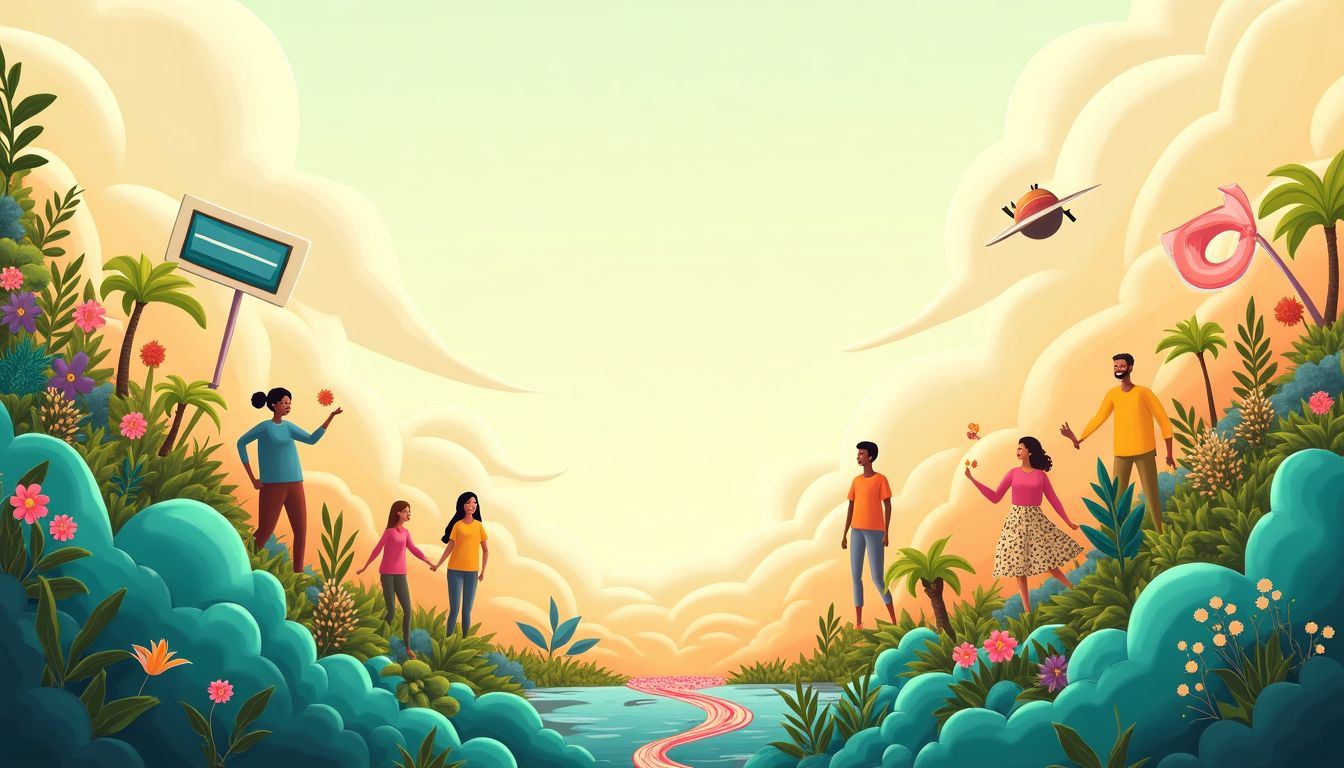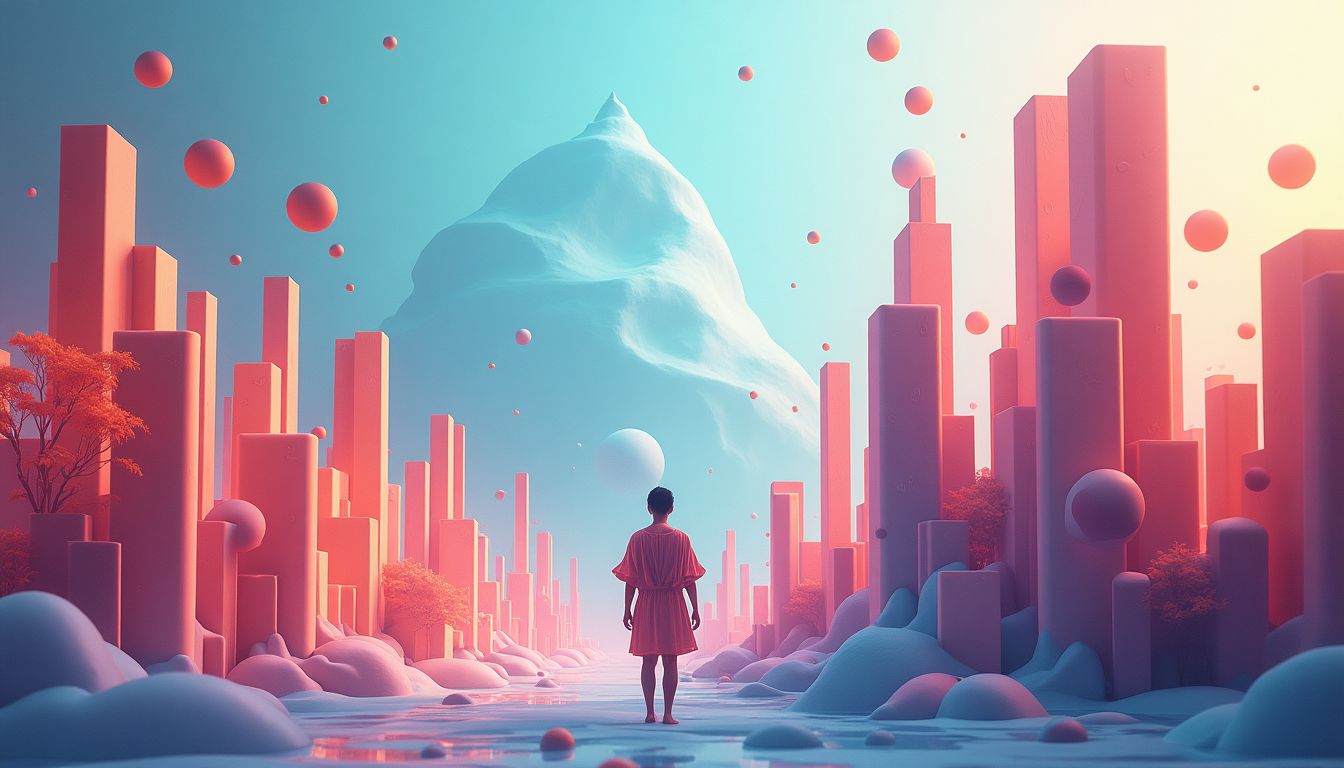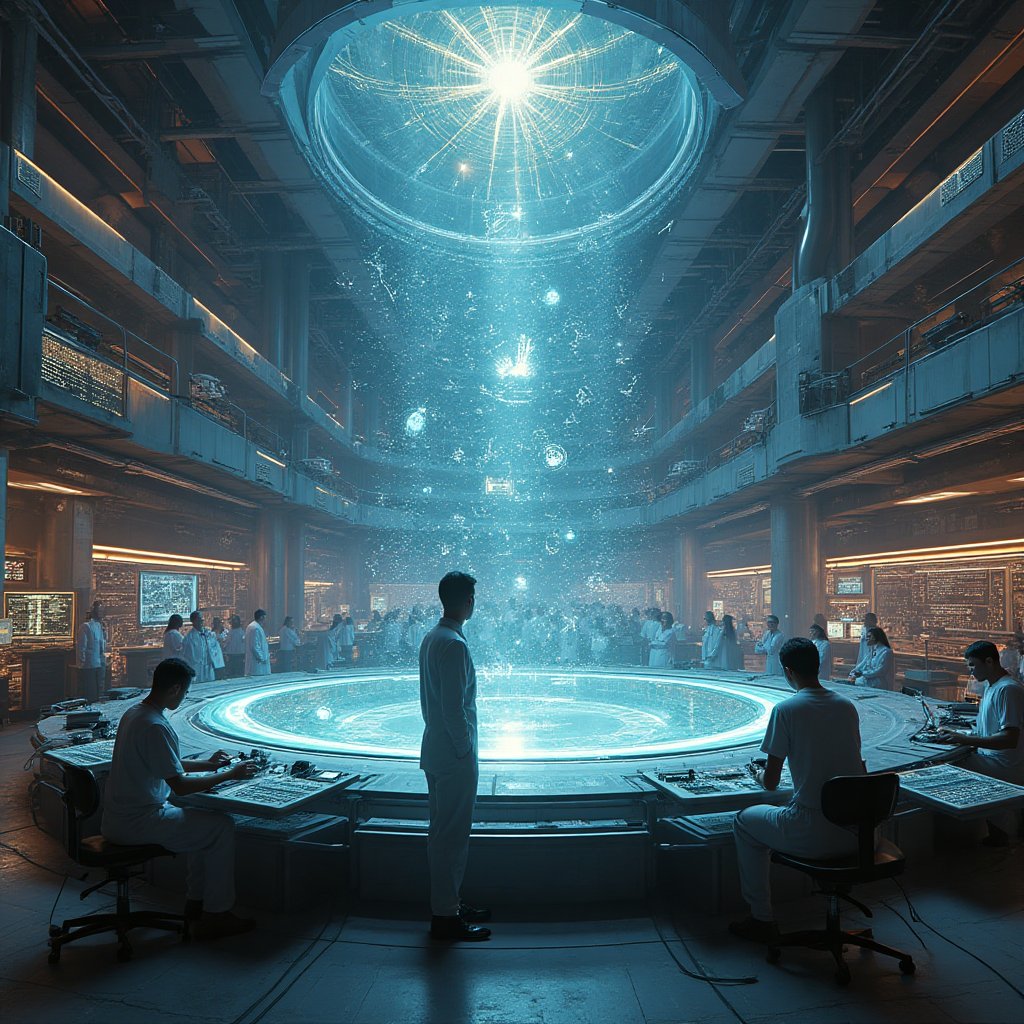The Introduction Title
The measure of intelligence is the ability to change. — Albert Einstein. This insight from the iconic physicist reflects a profound truth about growth: progress often emerges from adapting to challenges and obstacles. In a world moving increasingly toward automation and artificial intelligence, we face an intriguing question: what happens when the proverbial bumps in the road are smoothed out? As we approach a potential post-work era, free from traditional struggles, we must ask ourselves—will the absence of these challenges hinder our ability to grow, both as individuals and as a society?
In this age of technological marvels, where even your refrigerator might soon be able to quiz you about your dietary choices, the stakes feel higher than ever. A world devoid of struggle has a certain allure, yet could we risk stagnation in the absence of the very challenges that have paved the way to our greatest achievements? This article will navigate the multifaceted implications of a future where struggle may become a quaint relic of the past. We’ll dive into the philosophical, psychological, and economic aspects of this brave new world, seeking to determine if personal and societal growth can persist without the fuel of adversity. Ready to explore the unknown?
1. The Historical Context of Struggle and Growth
To grasp the intricacies of a future without struggle, we first need to look back at how hardship has shaped our history. Every era that has seen substantial growth has also experienced its fair share of turmoil. From the great agricultural revolutions to the bustling Industrial Age, history has shown that challenges often lead to remarkable innovation and adaptation.
1.1 Development Through Adversity
Take, for example, the aftermath of World War II. The devastation and upheaval that ensued did not crush society; rather, it ignited a wave of innovation, from technological advancements to the establishment of social safety nets. Nations rebuilt and redefined their paths forward, demonstrating the profound impact adversity can have on growth.
1.2 Lessons from the Past
As we reflect on the myriad struggles human beings have faced, we unearth valuable insights. Famous thinkers—like Simon Sinek, who argues that a strong sense of purpose leads to fulfillment, and Brené Brown, who emphasizes the importance of vulnerability—have shown us that facing challenges fosters resilience and innovation. These lessons become vital as we contemplate the implications of a world that may lack struggle, forcing us to ask: What will motivate our growth in this new landscape?
2. Psychological Implications of a Struggle-Free Existence
The human mind is a curious puzzle, shaped by challenges as much as by victories. But what happens when life turns into a smooth ride? Do we become like jelly, wobbling around without a care in the world? In this section, we dive into how a lack of struggle might change our motivation and, ultimately, our growth.
2.1 Motivation Theories Revisited
First, let’s take a quick peek at what motivates us. There are two main types of motivation: intrinsic and extrinsic. Intrinsic motivation is when we do things just because we love doing them. Think of your buddy who paints just for the joy of it. On the other hand, extrinsic motivation comes from external rewards, like getting a pizza for finishing your homework. In a post-work world, where challenges are minimal, will the fire of intrinsic motivation burn brightly? Or will it flicker like a dying light bulb? Studies suggest that without hurdles, people might lose their drive to excel, as seen in research by Psychology Today, which indicates that lack of difficulties can lead to boredom.
2.2 The Dangers of Complacency
Now, let’s chat about complacency – that cozy feeling when you sink into your couch and decide to watch Netflix for the fifth time this week. Complacency might sound nice, but it can be a slippery slope. Without challenges, we can drift into a dull routine that stifles our potential. Imagine a world where people trade dreams for video games. Yikes! We could see increases in anxiety and feelings of emptiness, which are evidenced by statistics from World Health Organization (WHO). So, while a struggle-free life could sound like paradise, it might turn out to be more like a beige consolation prize instead of a colorful tapestry of human experience.
3. Economic Consequences of Eliminating Work
So, let’s say we've waved goodbye to traditional jobs and embraced a future with Universal Basic Income (UBI). Yay for free money, right? But wait! What does that mean for our economy? Can our wallets still grow fat, or will they flatten out like a pancake? In this section, we explore how our economic landscape might change when struggle fades into the sunset.
3.1 Revising Economic Theories
To make sense of this new world, we might need to dust off old economic theories and give them a makeover. Traditional economics often hinges on labor, income generation, and scarcity. But if we’re swimming in resources with little need to work, the rules might need rethinking! Renowned economist IMF suggests that societies could adopt new economic models emphasizing sustainability and leisure over labor. Picture an economy where the hustle and bustle are replaced by more leisure time. Who knows? We might finally have time to bake that ridiculously complicated soufflé we’ve been eyeing on Pinterest!
3.2 New Paradigms for Wealth Distribution
Without the traditional structure of job-based income, we face certain challenges concerning wealth distribution. Can everyone be made equally rich, or will we end up with a situation worse than Monopoly? There needs to be a system in place to ensure fair distribution of resources. Ideas like Universal Basic Income (UBI) are gaining traction, but biases and economic disparities still loom large. Imagine living in a world where wealth is shared more evenly; it's the classic “rise together or sink together” scenario. A balanced economy could lead to improved social cohesion and happier communities, but it’s a tightrope walk without a safety net!
4. Societal Growth in a Struggle-Free Future
Imagine a world where the very fabric of society is woven without the threads of hardship or challenge. What would happen to our values, our relationships, and our overall purpose? A future without struggle may lead to some significant changes, but it also raises many questions. Would we redefine success? Would community bonds strengthen or weaken? This section dives into how societal growth might transform when the need for struggle diminishes.
4.1 Redefining Success
As we progress towards a struggle-free environment, society may begin to rethink what success means. Traditionally, we often associate success with overcoming obstacles, achieving personal goals, or winning competitions. However, in a world devoid of challenge, this perspective could shift dramatically.
Here’s a possible framework for how success might be redefined:
- Cooperative Achievements: Success may include collective goals achieved through teamwork rather than individualistic competition.
- Personal Fulfillment: Emphasis might shift to personal growth, happiness, and satisfaction rather than wealth or status.
- Social Impact: Making a difference in community welfare could become a primary indicator of success.
4.2 Fostering Community and Connection
In a society where struggle is minimized, the focus on building community and connection may become even more crucial. Without economic stressors, people may have the time and capacity to invest in their social networks.
Consider the following aspects:
- Increased Social Engagement: Freed from the grind of traditional work, individuals may engage more in community events and volunteerism.
- Stronger Bonds: Relationships could deepen as people find common interests and collaborate on projects that benefit the broader community.
- Support Networks: Community-based support systems may thrive in a post-work world, providing emotional and psychological assistance to individuals.
5. Potential for Innovation and Creativity Without Challenges
The absence of struggle raises an intriguing question: Does a lack of challenges stifle creativity, or does it provide fertile ground for innovation? Historically, constraints have often driven creativity, spurring innovative solutions to overcome obstacles. But might a free and stressless environment enhance creative thinking instead?
Throughout this exploration, we'll examine how innovation and creativity could unfold in a world where people are no longer tethered by traditional struggles.
5.1 Innovations Born from Adversity
History is filled with examples of how adversity has sparked significant innovations. The following are notable examples:
| Challenge | Innovation | Impact |
|---|---|---|
| The Great Depression | Social Security | Established a safety net for the elderly and unemployed. |
| World War II | Radar Technology | Revolutionized military and civilian communication. |
| Natural Disasters | Earthquake-resistant buildings | Enhanced urban safety and reduced casualties. |
5.2 Enabling Creativity through Freedom
On the flip side, a frictionless environment could actually enhance creativity. Picture a space where individuals aren’t constrained by the weight of survival, allowing them to explore thoughts and ideas freely. Here are ways this could manifest:
- Exploration of Interests: Without time constraints from traditional work, individuals could dive into hobbies and passions, leading to unexpected creative breakthroughs.
- Collaboration and Brainstorming: With more time and energy dedicated to group projects, creative collaboration may flourish and give rise to innovative ideas.
- Access to Resources: With Universal Basic Income (UBI) or similar models, individuals might have better access to tools required for creativity and innovation.
6. AI Solutions: How would AI tackle this issue?
In a future devoid of traditional struggle, could AI provide the impetus for growth? By leveraging machine learning, AI can analyze vast data patterns to predict and create learning opportunities that simulate challenges. Here’s how AI could tackle personal and societal growth challenges:
6.1 Intelligent Simulation of Challenges
As humans, we're often motivated by challenges. AI can step in to create simulations that emulate challenges tailored to individual needs, encouraging personal development. By using advanced algorithms, AI can generate scenarios that push us to adapt, learn, and evolve, providing a framework for growth even in a frictionless environment. Imagine an OpenAI system that presents both career-related projects and interpersonal challenges, nudging users to develop resilience and skills normally honed through adversity.
6.2 Personal Development Algorithms
AI's analytical prowess can help devise algorithms that match individuals with growth opportunities based on their interests and strengths. Utilizing platforms like LinkedIn to analyze profiles and career trajectories, AI can identify skill gaps and recommend courses, mentorships, and collaborative projects to encourage continuous learning and improvement. The magic lies in making learning feel organic and beneficial rather than obligatory. This way, the pathway to growth can be more fulfilling.
6.3 Promoting Collaborative Learning
AI platforms could enhance community engagement by promoting collaborative learning opportunities. The collective intelligence of various individuals can create a rich tapestry of shared experiences and ideas. Tools like TED Talks and online discussion forums can be integrated with AI recommendations to build supportive networks, inspiring peer learning and collective growth. AI could analyze group dynamics and encourage interactions that foster a sense of community while reinforcing individual development.
Actions Schedule/Roadmap
This detailed timeline outlines actionable steps from Day 1 to Year 2 for realizing effective growth strategies in a post-work society, facilitated by AI technology:
Day 1: Foundation Setting
Build a multidisciplinary team comprising psychologists, economists, AI experts, and sociologists to brainstorm and formulate growth frameworks in absence of struggle. Initial meetings will focus on identifying goals and expected outcomes for the project.
Day 30: Research and Data Collection
Conduct comprehensive analyses on human behavior in stress-free settings. Utilize existing studies from institutions like the Harvard University, gathering insights on motivation and engagement without traditional work forces.
Month 2: Formulate Initial Hypotheses
Develop hypotheses on potential models of growth in a struggle-free environment. This stage may also involve digital simulations of growth processes based on current academic theories, enabling real-time adjustments based on findings.
Month 3: Identify and Onboard Key Stakeholders
Engage with corporations, educational institutions, and community groups invested in exploring models of growth, like edX and Coursera. Secure community buy-in by showcasing potential benefits for local and global societies.
Month 6: Prototype AI Tools
Begin creating and testing AI models designed to simulate personalized growth challenges. Partner with tech platforms like IBM Watson to leverage their AI expertise and cloud resources.
Year 1: Community Involvement
Implement pilot programs in communities aiming for qualitative data on individual aspirations and definitions of success. Regular feedback loops will ensure that AI solutions are adaptable and relevant as real-world application unfolds.
Year 1.5: Analyze and Adjust
Analyze results from AI-simulated challenges and community feedback. Adjust algorithms based on user experiences, while continuously identifying new methods for stimulating personal growth without traditional struggle. Consult with thought leaders from organizations like Forbes and McKinsey & Company for insights into emerging trends and best practices.
Year 2: Rollout and Efficiency Optimization
Launch a broader platform that incorporates insights gained from pilot programs. Build on success stories to promote the model in academic, corporate, and governmental institutions while ensuring inclusivity across diverse populations. Evaluate metrics continuously to align with desired growth outcomes.
Conclusion: Imagining a Struggle-Free Growth Landscape
In contemplating a future liberated from the toil of traditional labor, we are both invigorated and wary. While we have the potential to thrive without imposed struggles, understanding how to harness the benefits of challenge-free growth is pivotal. The challenge is not to eliminate adversity completely but to redefine it in such a way that it catalyzes personal and societal advancement. The intersection of AI solutions and human growth highlights an exciting frontier, where technology serves as a collaborator rather than a competitor. Integration of AI into growth strategies brings forth a tapestry woven with innovation, collaboration, and compassion, underscoring the innate human desire for connection and progress. By embracing this potential, we may find ourselves stepping into a future that is not only sustainable but also empathetic—one where personal fulfillment and societal harmony coexist harmoniously.
Frequently Asked Questions
Q1: What is a post-work era?
A post-work era refers to a future in which technology like artificial intelligence (AI) and automation significantly reduce the need for traditional jobs. This shift means that fewer people may need to work in the same way they do today, leading to a redefinition of what work and success means for society.
Q2: Can we grow without struggle?
While many believe challenges help us grow, it's possible to develop personal and societal growth in different ways. For instance, psychological studies suggest that growth can also come from supportive environments and new frameworks that encourage learning without the need for traditional hardships.
Q3: How does AI play a role in this new world?
AI could help us understand human behavior and develop personalized methods to encourage growth. With machine learning, AI can analyze patterns and create tailored opportunities for people to learn and grow in ways that suit them best.
Q4: What challenges come from a world without struggle?
Without challenges, individuals may face risks like:
- Boredom: Too much free time without tasks can lead to feeling unproductive.
- Anxiety: Lack of a purpose or challenge can create feelings of unease.
- Loss of identity: Work plays a significant role in how people identify themselves.
Q5: How can society ensure fair growth in a post-work world?
To achieve equity in growth, communities may need to adopt innovative policies and practices, such as:
- Universal Basic Income (UBI): A program that provides everyone with a regular, unconditional payment.
- Focus on community and collaboration: Encouraging interactions that strengthen social bonds.
- Revising education systems: Adapt learning to include skills for a changing economy.
Q6: What role does education play in adapting to a post-work world?
Education will need to evolve to prepare individuals for new challenges. This could mean emphasizing creativity, critical thinking, and emotional intelligence instead of traditional skills. For instance, initiatives from Edutopia promote innovative teaching methods that are essential for future generations.
Q7: Can creativity thrive without challenges?
While challenges often fuel innovation, it's possible that greater freedom can inspire creativity in new ways. The absence of struggles could lead to more time and space to think creatively, focusing on passion projects and new inventions without the pressure of deadlines or financial survival.
Q8: Are there historical examples of growth after challenges?
Many societies have thrived following significant crises. For example, the post-World War II era saw rapid growth in technology and economic prosperity as nations rebuilt and innovated.
Q9: How can communities adapt in a post-work society?
Communities might become more interconnected, focusing on shared experiences and collaboration over competition. This transformation could lead to stronger relationships and support systems. Programs that promote local activities, like community gardens or cultural festivals, can help nurture these connections.
Q10: What personal steps can individuals take to prepare for a post-work future?
Individuals can start adjusting their mindsets and skills by:
- Exploring hobbies that spark joy and creativity.
- Networking with others who share similar interests, building a support system.
- Finding ways to stay informed about technological advancements and their impacts on society.
Wait! There's more...check out our gripping short story that continues the journey: A Kaleidoscope of Resistance
Disclaimer: This article may contain affiliate links. If you click on these links and make a purchase, we may receive a commission at no additional cost to you. Our recommendations and reviews are always independent and objective, aiming to provide you with the best information and resources.
Get Exclusive Stories, Photos, Art & Offers - Subscribe Today!





























Post Comment
You must be logged in to post a comment.